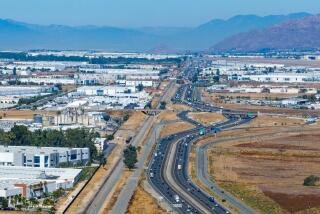San Diego Exempts 5,600-Unit Development From IDO
- Share via
The San Diego City Council on Tuesday approved the first large-scale exceptions to its slow-growth Interim Development Ordinance, releasing a planned community of 5,600 residential units and three smaller projects from the landmark regulations intended to cap city growth.
With only Mayor Maureen O’Connor dissenting, the council agreed to allow the Carmel Mountain Ranch community off Interstate 15 in the city’s northeastern section to continue to grow into what will ultimately be a 1,600-acre development with residential, commercial and industrial buildings.
Developers Met Criteria
The council agreed with developers’ claims that Carmel Mountain Ranch has complied with the criteria for release from the slow-growth ordinance, primarily by constructing some of the community’s vital public facilities before building residences.
The IDO, which caps residential development citywide at 8,000 units between July, 1987, and January, 1989, is intended to ensure that the construction of schools, parks, sewers and other public facilities keeps pace with home building.
“This is a planned community,” Councilwoman Gloria McColl said. “They have done everything the city has asked. They have stepped forward with their own money to put in the public improvements. I think it would be wrong to change the rules at this time.”
O’Connor said, however, that she opposed relinquishing city control over a community the size of Carmel Mountain Ranch. “It gives them a long-term release, and I’m not sure we want to do that,” she said. O’Connor added that she was not yet “comfortable” with criteria for releasing communities from the IDO.
The council also approved three exemption requests from developers of residential projects, which are substantially smaller than full communities such as Carmel Mountain Ranch. Approved were a 96-unit complex at 7225 Girard Ave. in La Jolla, an 84-unit development on Gilman Drive in La Jolla and a development of 15 single-family homes on Glendover Lane in Mira Mesa.
On Nov. 17, the council approved its first exemptions for projects of less than four units, granting relief to 13 applicants to build 30 units.
Carmel Mountain Ranch, which won city approval in 1984, was the second community plan to undergo council consideration for release from the IDO. The council deadlocked in two 4-4 votes Nov. 24 over the future of the Miramar Ranch North. That project will come back before the council for consideration next week.
As the first community to escape the restrictions of the IDO, Carmel Mountain Ranch sets something of a precedent for the five other communities that may eventually come before the council, said Paul Peterson, the developers’ attorney.
“The release really was the recognition of the council that they’re going to follow the IDO,” Peterson said. “They’ve built this into the IDO, and they’re going to make a release in an appropriate case.”
But Peterson and others said that the community’s heavy investment in public facilities made it especially appropriate for exemption. Carmel Mountain Ranch officials argued that they have met the needs of the families who will move into the development by installing those facilities before residential occupancy.
Though just 623 homes are occupied, the developers have already installed $20 million in public facilities and have an additional $17 million of publicly oriented construction under way. The developers have also promised to add $18 million more in facilities.
Already built are industrial and commercial pump stations, a reservoir, a water main, and some small roads. Under construction are main arteries including state Highway 56 from I-15 to Pomerado Road, a fire station and two parks, said Laurie McKinley, director of planning for Carmel Mountain Ranch.
“We do definitely meet the criteria you adopted last week for a released community, and we ask today that you recognize that and release” Carmel Mountain Ranch, McKinley said.
Too Many I-15 Cars Already
Kathy Giles, chairwoman of the Sierra Club’s city land use committee, argued that the community will pour more cars onto heavily congested I-15, which already operates far above its capacity at rush hours and will continue to do so even with planned improvements over the next 15 years.
“In no time, we’re going to be like L.A. and like Orange County,” Giles said. “I urge you to break that mold and to start now. Don’t release communities from the IDO.”
But McKinley said that measures to accommodate the increased auto traffic were included when Carmel Mountain Ranch was approved by the city three years ago.
Complicating the decision was the fact that the city had granted the community a development agreement in 1985. Under state law, the agreement prohibits the city from imposing additional restrictions on development, the developers claimed. But Deputy City Atty. Janis Gardner ruled that the council could regulate the timing of the construction.
More to Read
Sign up for Essential California
The most important California stories and recommendations in your inbox every morning.
You may occasionally receive promotional content from the Los Angeles Times.










